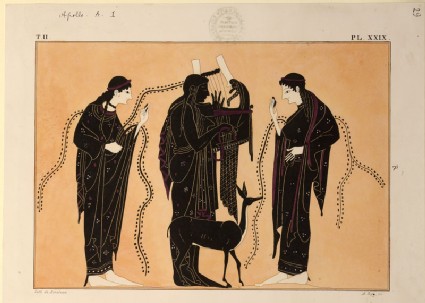Browse: 1470 objects
- Reference URL
Actions
Print of the Decoration on a Greek Amphora, showing Apollo and two Women P. Bineteau
-
Curator’s description:
Description
The lithograph shows Apollo in the centre, holding his lyre. A fawn stands beside him, and a woman stands to either side. The print reproduces the decoration of a black-figure amphora, recorded in 1838 with the Roman dealer Depoletti. It was plate XXIX in the second volume of Lenormant and de Witte's "Elite des monuments céramographiques", published in 1857. It was presumably taken from Ruskin's copy of the work now preserved in the Ruskin Library (inventory no. 1996B2621), which is missing many of its plates.
The print was first catalogued by Ruskin in 1870, as no. 207 in the Standard Series, framed with another print from Lenormant and de Witte of a red-figure illustration of Apollo; they formed part of a series 'arranged chiefly with the view of showing the change in Greek conception of deity'. It retained its number in the 1871 catalogue of the Standard and Reference Series but, by the time Cook and Wedderburn were compiling their edition of the catalogues (published in 1906), the frame had been moved to no. 189. Cook and Wedderburn note (XXI.45 n. 1) that it carried its original number (207) on the edge of its frame, but the new number (189) on the face. Presumably, it was easier to engrave and attach a new ivory label on the edge of the frame than it was to remove or gild over the painted number on the face.
According to Ruskin, the change in the ancient Greek conception of deity took place between the sixth and fourth centuries BC, and was marked by a development from conceiving of the gods as embodiments of physical forces to individual, characterised intelligences; from active to passive figures; and from grotesque to deliberately-selected beautiful depictions. At the same time, ceramic decoration changed from painting black figures on the red ground to painting a black background, letting the red ground show through in the figures themselves - though this soon led to careless execution. He believed the best vases were red-figure vases produced just after the transition (Catalogue of Examples, pp. 25-27; Standard and Reference catalogue, pp. 28-30).
Ruskin described the print as showing 'Apollo, the sun of morning': discussing the frame in his lecture on "Light" on 16 March 1870, Ruskin described him 'walking on the earth, god of the morning, singing to her lyre, the fawn beside her, again with the gleam of light on its breast' (Lectures on Art, § 154 = XX.148; the image was reproduced as figure 3 = XX.148). Ruskin also discussed the depiction of the light on the fawns' breasts in the upper images in Reference Series nos 187, 188 and 189: he suggested that it might express 'the direction of the light, when that direction is important'. He believed that the fawn symolised 'wavering and glancing motion on the ground, as well as of the light and shadow through the leaves, chequering the ground as the fawn is dappled'. (Lectures on Art, §§ 155-156 = XX.148-149.)
-
Details
- Artist/maker
-
P. Bineteau (active c. 1857 - c. 1858) (printer)A. Rey (active c. 1844 - c. 1858) (lithographer)
- Object type
- Material and technique
- watercolour and bodycolour over lithograph on wove paper
- Dimensions
- 207 x 297 mm (stone); 251 x 349 mm (sheet)
- Inscription
- Recto, all printed, around the image:
top left: T.II.
top right: PL. XXIX.
bottom left: Lith. de Bineteau.
bottom right: A. Rey, sc.
Recto, in manuscript, all in ink:
top, towards left: Apollo . A. 1
top right corner, written down the page: 29
right centre, written down the page: R
Verso, top centre, the Ruskin School's stamp
- Provenance
-
Presented by John Ruskin to the Ruskin Drawing School (University of Oxford), 1875; transferred from the Ruskin Drawing School to the Ashmolean Museum, c.1949.
- No. of items
- 1
- Accession no.
- WA.RS.REF.189.a
-
Subject terms allocated by curators:
Subjects
-
References in which this object is cited include:
References
Ruskin, John, Catalogue of Examples Arranged for Elementary Study in the University Galleries (Oxford: Clarendon Press, 1870), cat. Standard no. 207
Lenormant, Charles, and Jean de Witte, Elite des monuments céramographiques: Matériaux pour l'histoire des religions et des moeurs de l'antiquité, 4 vols in 8 (Paris: Leleux, 1844-1861), vol. II, pl. XXIX
Ruskin, John, Catalogue of the Reference Series Including Temporarily the First Section of the Standard Series (London: Smith, Elder, [1872]), cat. Reference no. 207
Ruskin, John, ‘The Ruskin Art Collection at Oxford: Catalogues, Notes and Instructions’, Edward T. Cook and Alexander Wedderburn, eds, The Works of John Ruskin: Library Edition, 39 (London: George Allen, 1903-1912), 21, cat. Reference no. 189
Ruskin, John, ‘Lectures on Art: Delivered Before the University of Oxford in Hilary Term, 1870’, Edward T. Cook and Alexander Wedderburn, eds, The Works of John Ruskin: Library Edition, 39 (London: George Allen, 1903-1912), 20, figure 3 = XX.148
Location
-
- Western Art Print Room





